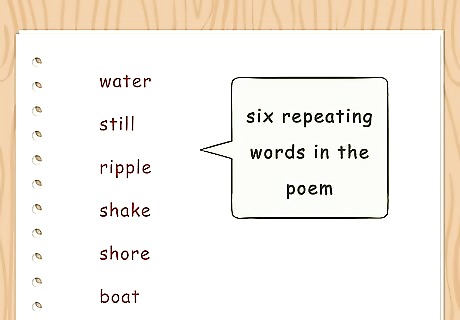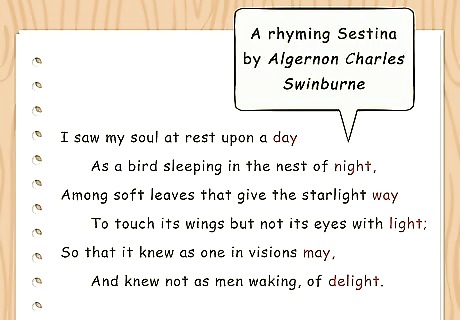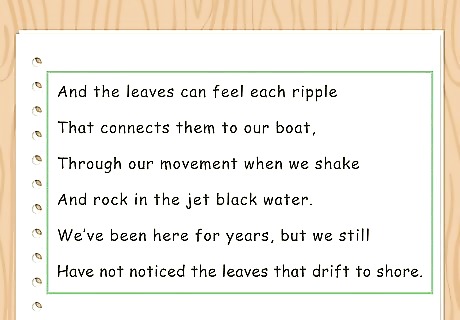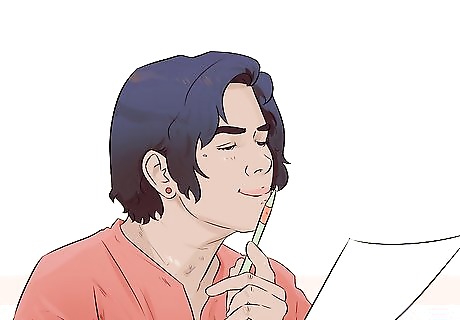
views
Brainstorming Ideas for the Sestina

Focus on a specific theme or idea. Sestinas often explore a theme or idea in detail. Themes like love, death, war, loss, and nature are all good options. Try to interpret a theme or idea from your perspective. Ask yourself, What does love or war mean to me? How has loss and death affected my life? What can I say that is unique or new about nature? For example, you may write a sestina about love by focusing on your love for your older sister. You may compose the sestina with memories or feelings you associate with your sister.

Choose a particular experience or moment. You can also focus on a memorable event or experience in your life as inspiration for the sestina. Think of any event that was life changing for you or that shifted your view on the world. Write about an experience that affected you in a big way as a person. For example, you may write a sestina about your first kiss or your first time swimming in the ocean.

Study the structure of the sestina. The sestina follows a strict pattern where you use the six end words of the first stanza in the remaining five stanzas. Each stanza is six lines long. The poem ends with a three line envoi, also known as a tornada. If you label each word with a letter (e.g. A, B, C, D, E, F), the poem will follow this line pattern: Stanza 1: A, B, C, D, E, F Stanza 2: F, A, E, B, D, C Stanza 3: C, F, D, A, B, E Stanza 4: E, C, B, F, A, D Stanza 5: D, E, A, C, F, B Stanza 6: B, D, F, E, C, A Envoi: B, E Envoi: D, C Envoi: F, A The order may seem complicated at first, but it simply involves "folding". If you imagine a line of, say, beads on a string, labeled A–B–C–D–E–F, and then "fold" this line down the middle, you end up with F–A–E–B–D–C. Then continue this process for the remaining stanzas. When you get to stanza 6, notice that the first three end words are used in the middles of the envoi's lines, and the last three end words are used at the ends of the envoi's lines. The envoi must include the remaining three end words in the poem. This way, the six recurring words appear in the final three lines of the poem. A sestina does not have to rhyme.

Read examples of the sestina. Study successful examples of the form so you get a better sense of how to write your own. 19th century poets as well as modern poets have used the sestina to express their emotions, including: “Sestina: Alforte” by Ezra Pound “Farm Implements and Rutabagas in a Landscape” by John Ashbery “A Miracle for Breakfast” by Elizabeth Bishop “O Light Red Light” by Cathy Park Hong
Writing the Sestina

Identify the six repeating words in the poem. Choose six words that are versatile and evocative. You will need to reinterpret these six words throughout the poem, so go for words that are specific enough but also open to interpretation. You may choose a few words that are nouns or verbs. Avoid using adjectives, unless you feel you can interpret the adjective more than one way. For example, for a poem about your love for your older sister, you may choose: “sister, share, hold, learn, bright, blood.”

Write around your six chosen words. Rather than try to write each stanza of the sestina in order, arrange the six repeating words in their set places using the pattern of the sestina. Then, write around them, focusing on describing your subject in detail. Try to interpret the chosen words in different ways each time they appear in the poem. For example, you may have one line refer to your sister as a “bright star” and another line later refer to the “bright look on her face.”

Decide if you will use rhyme. Sestinas do not have to rhyme and many modern sestinas do away with rhyme completely. But you can integrate rhyme into the lines of your sestina to give it more rhythm. Try rhyming two words side by side in one line of the sestina to give the sestina an interesting sonic quality. For example, you may use a rhyme like “blood good” or “bright might.”

Use metaphors and similes. Metaphors are when you compare one thing to another. For example, “My sister is a blood flower in winter.” Similes are when you compare one thing to another using “like” or “as.” For example, “My sister is like a bright star at night.” Using metaphors and similes in your sestina will make it stronger and more engaging. Often, metaphors are considered more effective than similes. Try using a mix of metaphors and similes to add variety to your sestina.

Focus on sensory details and imagery. Integrate the five senses into the sestina, focusing on how your subject looks, sounds, feels, tastes, and smells. Describe the subject using rich imagery that is particular and unique. Avoid cliche or familiar imagery, as this will weaken the poem. For example, for a poem about your older sister, you may focus on how she smells when she’s angry or upset, or how she sounds when she being affectionate towards you.

End on a high note. A good sestina will use the last three lines of the poem to wrap things up in a dramatic way. You may choose to flip around the meanings of the six recurring words for a dramatic finish. Or you may wrap up a narrative with a strong ending in the last three lines of the poem. For example, in Ezra Pound’s “Sestina: Alforte,” he uses exclamation marks and a reinterpretation of the word “peace” to end the poem: “And let the music of the swords make them crimson!/Hell grant soon we hear again the swords clash!/Hell blot black for always the thought “Peace!””
Polishing the Sestina

Read the sestina out loud. Once you have a draft of the sestina, read it aloud to yourself. Listen to how the words sound in each stanza. Notice if each stanza flows well into one another. Underline or circle any awkward lines so you can revise them later. You can also read the sestina aloud to others to get their feedback. Ask them to tell you how it sounds as you read it aloud to them.

Show the sestina to others. Get constructive criticism about the sestina from peers, friends, teachers, and family members. Ask them if they feel the sestina flows well and explores a certain theme or idea clearly. Have them give you suggestions on ways you can improve the poem and make it better.

Revise the sestina for rhythm, sound, and flow. Go through the sestina and make sure it has a certain rhythm to it. Confirm it follows the strict pattern for a sestina. Look for interesting sounds made by pairing certain words or lines together. Make sure all the words in the sestina are spelled correctly and that the punctuation and grammar is correct.

Give the sestina a title. You can use a line that you like from the sestina as the title or title the sestina with the theme or idea explored in it. You may also title it simply “Sestina,” though this may not be the most exciting way to get a reader’s attention. For example, a title for a sestina about your older sister might be, “Sestina: My Sister,” or “Bright, Blood, Sister.”




















Comments
0 comment